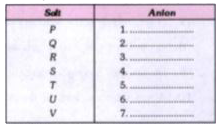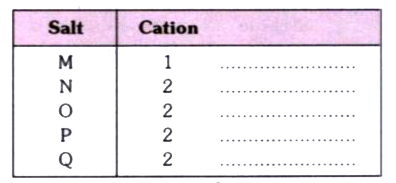Identify the substance Q based on the information given below:
The white crystalline solid Q is soluble in water. It liberates a pungent smelling gas when heated with sodium hydroxide solution.
Step by step video & image solution for Identify the substance Q based on the information given below: The white crystalline solid Q is soluble in water. It liberates a pungent smelling gas when heated with sodium hydroxide solution. by Chemistry experts to help you in doubts & scoring excellent marks in Class 10 exams.
Updated on:21/07/2023Topper's Solved these Questions
- STUDY OF COMPOUNDS - AMMONIA BOOK - ICSECHAPTER - STUDY OF COMPOUNDS - AMMONIA EXERCISE - ADDITIONAL QUESTIONS
30 Videos
- STUDY OF COMPOUNDS - AMMONIA BOOK - ICSECHAPTER - STUDY OF COMPOUNDS - AMMONIA EXERCISE - UNIT TEST PAPER 7B - AMMONIA
22 Videos
- STUDY OF COMPOUNDS - AMMONIA BOOK - ICSECHAPTER - STUDY OF COMPOUNDS - AMMONIA EXERCISE - UNIT TEST PAPER 7B - AMMONIA
22 Videos
- STUDY OF ACIDS, BASES AND SALTSBOOK - ICSECHAPTER - STUDY OF ACIDS, BASES AND SALTSEXERCISE - ASSERTION AND REASON BASED QUESTIONS
5 Videos
- STUDY OF COMPOUNDS - HYDROGEN CHLORIDEBOOK - ICSECHAPTER - STUDY OF COMPOUNDS - HYDROGEN CHLORIDEEXERCISE - UNIT TEST PAPER 7A - HYDROGEN CHLORIDE
28 Videos
Similar Questions
Identify the substance R based on the information given below:
The pale green solid R turns reddish brown on heating. Its aqueous solution gives a white precipitate with barium chloride solution. The precipitate is insoluble in mineral acids.
View SolutionIdentify the substances P, Q and R in each case based on the information given below:
The salt P turns yellow on dissolving in water and gives a reddish brown precipitate with sodium hydroxide solution.
View SolutionIdentify the substance 'R' based on the information given below:
The pale green solid 'R' turns reddish brown on heating. Its aqueous solution gives a white precipitate with barium chloride solution. The precipitate is insoluble in mineral acids.
View SolutionSalts P, Q,R,S,T,U and V undergo reactions (i) to (vii) respectively. Identify the cation present in these salts on the basis of these reactions. Tabulate your answer in the formate given below.
(i) When the salt Pis heated with sodium hydroxide solution a vigorous reaction takes place and a colourless gas is evolved with a pungent and suffocating smell that brings tears in our eyes. The evolved gas gives dense white fumes with a moist glass rod depped with hydrochloric acid.
(ii) Addition of sodium hydroxide solution to a solution of salt Q gives a thick white precipitae which is soluble in excess of sodium hydroxide solution to form a clear solution.
(iii) Addition of ammonium hydroxide solution to a solution of salt R gives a dark blue precipitate which is soluble is excess of ammonium hydroxide solution to form an intense deep blue solution.
(iv) Addition of ammonium hydroxide solution to a solution of 5 gives a dirty green [bottle green] precipitate which is insoluble even in the excess of ammonium hydroxide solution.
(v) Addition of ammonium hydroxide solution to a solution of T gives a reddish brown (rust precipitate] precipitate which is insoluble even in the excess of ammonium hydroxide solution.
(vi) Addition of ammonium hydroxide solution to a solution of V gives a geletaneous white precipitate which is soluble in excess of ammonium hydroxide solution to form a clear solution.
(vii) Addition of ammonium hydroxide solution to a solution of V gives no precipitate but it gives a chalky white precipitate with sodium hydroxide solution which is insoluble even in the excess of sodium hydroxide solution.

View SolutionIdentify the salts P from the observations given below:
On performing the flame test salt P produces a lilac coloured flame and its solution gives a white precipitate with silver nitrate solution, which is soluble in Ammonium hydroxide solution.
View SolutionChoose the correct answer from the options given below :
Hydroxide of this metal is soluble in sodium hydroxide solution.
View SolutionIdentify the salts P & Q from the observations given below: i] On performing the flame test salt P produces a lilac coloured flame & its solution gives a white precipitate with silver nitrate solution, which is soluble in ammonium hydroxide solution. ii] When dilute HCl is added to a salt Q, a brisk effervescence is produced and the gas turns lime water milky. When NH4OH solution is added to the above mixture [after adding dilute HCI], it produces a white precipitate which is soluble in excess NH4OH solution.
View SolutionSalts M, N, O, P and Q undergo reactiom (i) to (v) respectively.
Identify the cation present in these salts on the basis of these reaction. Tabulate your answer in the format given below.
1. When sodium hydroxide solution is added to the salt M, and heated strongly a colourless gas with a pungent smell is evolved which turm red litmus paper blue and gives dense white fumes with a moist glass rod with hydrochloric acid.
2. Addition of dilute hydrochloric acid to a solution of N gives a thick white precipitate which is soluble in hot water.
3. When ammonium hydroxide solution is added to the solution of 0 a light blue precipitate is obtained which is soluble in excess of ammonium hydroxide to form an inteme deep blue solution.
4. When ammonium hydroxide solution is added to the solution of P reddish brown (mustard colour) precipitate is obtained which ,is insoluble even in the excess of ammonium hydroxide solution.
5. When sodium hydroxide solution is added to the solution of Q a which coloured gelatinous precipitate is obtained which is soluble in excess of sodium hydroxide to form a clear solution

View SolutionIdentify the salts Q from the observations given below:
When dilute HCl is added to a salt Q, a brisk effervescence is produced and the gas turns lime water milky. When NH4OH solution is added to the above mixture (after adding dilute HCl), it produces a white precipitate which is soluble in excess NH4OH solution.
View SolutionWhen liquid 'A' is treated with a freshly prepared ammoniacal silver nitrate solution it gives bright silver mirror. The liquid forms a white crystalline solid on treatment with sodium hydrogen sulphate. Liquid 'B' also forms a white crystalline solid with sodium hydrogen sulphate. but it does not give test with ammoniacal silver nitrate. Which of the two liquids is aldehyde? Write the chemical equations of these reactions also.
View Solution
